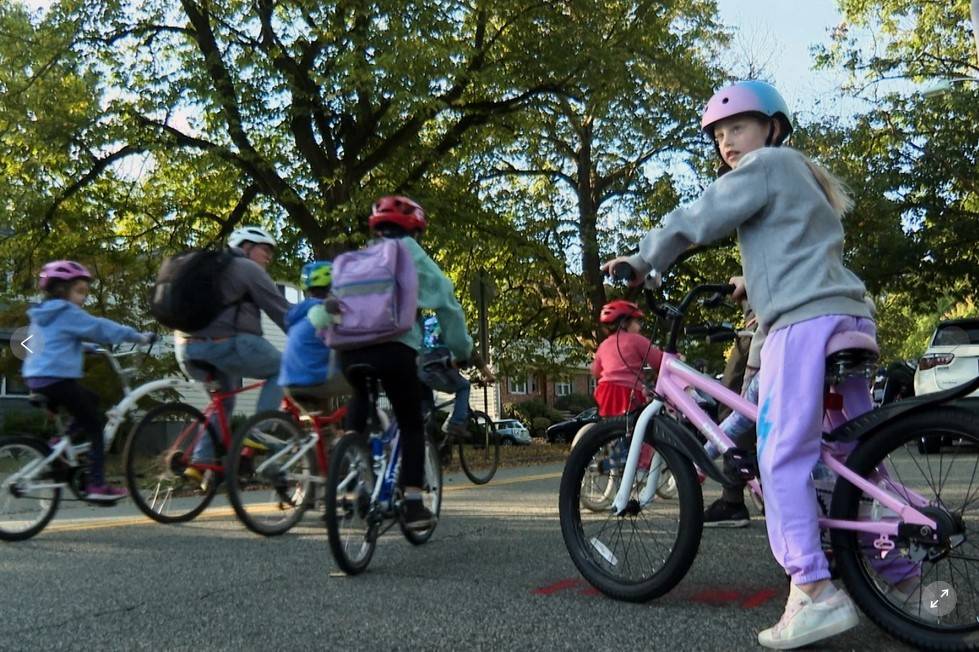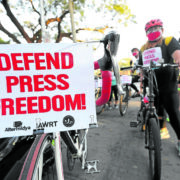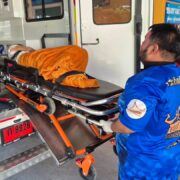More kids and parents biking together to school

MONTCLAIR, NEW JERSEY—On a sunny fall morning, children wearing helmets and backpacks gathered with their parents for a group bicycle ride to two local elementary schools.
Volunteers in orange safety vests made sure everyone assembled in a neighborhood shopping area was ready before the riders set off on their 8-kilometer (5-mile) “bike bus” route.
Every few blocks, more adults and kids on bikes joined in. Eventually, the group grew to over 350 people. Older students chatted with friends, while younger ones focused on pedaling. Cars along the way stopped to let the line of cyclists pass. Pupils and parents peeled off toward the first school before the remainder reached the group’s final stop.
It’s a familiar Friday scene in Montclair. For the past three years, what began as a handful of parents hoping to encourage their kids to bike to school has grown into a weekly ritual—and a regular commute option for many families.
Sense of community
“It was so fun,” student Gigi Drucker said upon arriving at Nishuane Elementary School.
“The best way to get to school is by bike because it gives you more exercise. It’s healthier for the Earth,” Drucker added.
But traveling to school on two wheels isn’t just for fun, according to organizer Jessica Tillyer, who believes biking together each week helps promote healthy habits for children and strengthens a sense of community among parents.
“And it really started because a small group of us, about five parents, all wanted to ride to school with our kids and just felt like it wasn’t safe. And for me, I felt kind of lonely riding by myself to school,” Tillyer said.
“So, bike bus just took off as a small effort. And now we can have up to 400 people riding together to school.”
The bike bus movement isn’t new. Hundreds of them exist throughout the United States and Europe, as well as in Australia, Brazil, India, Indonesia and Israel, according to Bike Bus World, a nonprofit organization that promotes and provides information about bike buses.
Cofounder Sam Balto, who established a bike bus in Portland, Oregon, more than three years ago, said interest has grown so much that he offers free coaching calls to help others launch their own. He estimates there are more than 400 routes worldwide and the number continues to grow.
“Children and families are craving community and physical activity and being outdoors. And when you present that versus a school car line, people naturally gravitate to something that’s super joyful and community-driven,” Balto said.
Organizers hope the bike bus movement will not only get more children on their bikes but also push elected officials in the United States and abroad to invest in safer biking infrastructure.
Growing a movement
While starting a bike bus may not be difficult, keeping it running year-round through different seasons takes more effort. Organizers of successful rides shared advice for parents hoping to create their own.
Andrew Hawkins, one of the leaders of Montclair Bike Bus, said that once enough families express interest, the first step is to plan a route carefully. That means identifying streets with low traffic while considering how many students can join at the starting point and along the way.
“It took us a while to come up with a route we were happy with, but we’re still ready to adjust if necessary,” Hawkins said. “Things can change. It could be that new groups of students move into a certain block, or traffic patterns shift, and you have to adapt.”
The Montclair group started via word of mouth and social media posts.
As the number of participants grew, the organizers created a chat group to coordinate and share weekly updates. They also reached out to other families through PTAs, school forums and other parent communication channels.
Regular schedule
Keeping a bike bus going year-round requires consistency, which means preparing to pedal when it’s raining or cold outside, Balto and Hawkins said.
Leaders monitor weather forecasts and decide whether to cancel a Friday ride due to unsafe conditions or to proceed as planned while reminding families to dress appropriately.
“As it gets colder, we tell everyone to make sure they have the right gear—gloves, neck warmers, warm jackets,” Hawkins said. “The idea is that kids should feel comfortable riding all year.”
Despite all the planning and coordination involved in running a regularly scheduled bike bus, experienced organizers say the key is simply to start. It can be as informal as two families riding to school together and sharing a flyer to spread the word, Balto said.
“If you’re consistent—once a week, once a month, once a season—it will grow,” he said.

















